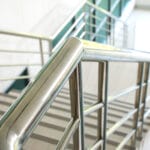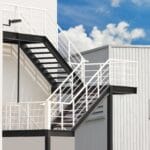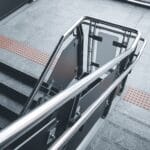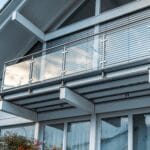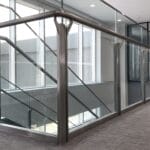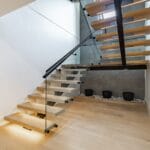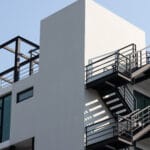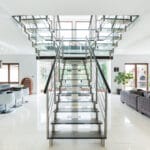Guardrails are much more than simple architectural elements: they provide essential protection against the risk of falls while adding aesthetic value to the space they occupy. Available in different materials such as aluminium, stainless steel, wood, or glass, each offers advantages and disadvantages to evaluate according to your needs, budget, and the harmony you want with your environment. Choosing the right guardrail means finding the balance between safety, durability, visual comfort, and integration with your project’s style.
Understanding safety standards for guardrails
Standard NF P01-012
Standard NF P01-012 specifies that any space presenting a fall risk of at least 1 metre or a drop with a slope of 45° or more must be equipped with a guardrail. The first 45 centimetres must be made of a solid material, and the space between the floor and the infill must not exceed 11 centimetres. These specifications aim to limit any risk of passage or tipping, especially for children, and ensure that the guardrail fully fulfils its protective role.
Standard NF P01-013
Standard NF P01-013 sets strength requirements:
- 60 daN for standard residential use
- 100 daN in public places
- 170 daN in high-traffic areas
These criteria ensure that the structure withstands daily use and accidental stresses, whether in a domestic setting or in places with heavy footfall.
Minimum height
To ensure an effective barrier, the minimum regulatory height is set at 1 metre. This dimension takes into account the protection of users of all sizes and significantly reduces the risk of falling by tipping over.
Spacing between elements
The spacing between horizontal elements must not exceed 18 cm, and between vertical elements, 11 cm. These limits prevent the risk of a child passing through and reinforce the integrity of the system.
Strength according to use
In areas with high traffic or crowd movement, the required strength is 170 daN. A properly sized guardrail manufactured according to these standards meets both safety and durability requirements.
Guardrail materials: options and characteristics
Material comparison
| Material | Advantages | Disadvantages | Initial cost | Maintenance |
| Aluminium | Lightweight, corrosion-resistant, customizable, easy to install | Less robust than stainless steel, impact sensitivity | Low to medium | Low |
| Stainless steel | Very durable, modern look, resists weather and humid environments | High initial cost | High | Very low |
| Wood | Warmth and natural aesthetics, adaptable to different styles | Regular maintenance, sensitive to insects and weather | Variable | High |
| Glass (with metal structure) | Contemporary design, lets light through, unobstructed view | Prone to soiling, requires frequent cleaning | High | Medium |
This table lets you quickly see the strengths and limitations of each option, helping guide your choice based on your priorities.
Aluminium
Aluminium appeals for its lightness, good corrosion resistance, and customization possibilities. Easy to work with, it can be painted or anodized to match different architectural styles. Its initial cost is generally lower than that of stainless steel, but its longevity depends on the care taken with its finish and installation.
Stainless steel
Stainless steel is known for its robustness, contemporary look, and exceptional resistance to the elements. Although the initial investment is higher, its durability makes it a cost-effective long-term solution. It retains its structural and aesthetic qualities with minimal maintenance, making it a preferred choice for outdoor guardrails or humid environments.
Wood
Wood brings warmth and authenticity. It can blend perfectly into traditional or natural environments. However, it requires regular maintenance to remain resistant to weather and insects. While its initial cost can be attractive, long-term maintenance must be considered.
Choosing the design of your guardrail
Aesthetic criteria
The style of the guardrail should complement the architecture of the location. A stainless steel design is perfectly suited to modern constructions, while wood is better suited to a traditional setting. Aluminium, for its part, offers great freedom of shapes and finishes, from industrial to contemporary styles.
Integration into the environment
Successful integration is based on visual and functional coherence:
- Wood : ideal for country houses or cottages
- Stainless steel: perfect for modern urban architecture
- Aluminium: versatile and adaptable to many contexts
Local climatic conditions (humidity, salty air, temperature variations) should also guide your choice.
Installation: key steps
Preparation
Measure the location precisely, check compliance with standards, and anticipate fixing points. This step determines the stability and safety of the installation.
Tools and materials
The equipment varies according to the type of guardrail:
- Aluminium: hacksaw, drill, appropriate fasteners
- Stainless steel: specific tools for precise cuts and clean finishes
- Wood: saw, drill, corrosion-treated fasteners
Having everything you need on hand helps avoid interruptions and ensures efficient assembly.
Calling a professional
Even if a DIY installation is possible for experienced handypeople, entrusting the installation to a professional guarantees compliance with standards and a flawless finish. An installer’s expertise also helps optimize the choice of materials and design according to use.
Maintenance: ensuring longevity and safety
Cleaning frequency
Monthly cleaning is recommended, especially in urban or marine environments. This prevents the accumulation of dirt and limits the risk of corrosion or material degradation.
Products to use
- Aluminium: mild cleaner and water
- Stainless steel: microfibre cloth, soapy water
- Wood: specific treatment and protection product
Product choice should always follow material-specific recommendations to avoid any damage.
Resolving common issues
Quick intervention on signs of rust, discolouration, or cracks helps extend the guardrail’s lifespan. Regular preventive maintenance prevents minor deterioration from turning into costly repairs.
Conclusion: making an informed choice
Choosing a guardrail depends on several factors: safety, budget, aesthetics, durability, and environmental constraints. A well-chosen and properly maintained guardrail not only ensures people’s safety but also contributes to the aesthetic enhancement of a space. For a safe, durable project that is perfectly integrated into your environment, Metanox supports you in designing and installing guardrails that combine safety, design, and long-term performance.
FAQ
How much does guardrail installation cost on average?
The price depends on the material, dimensions, and complexity of the installation. Custom projects may carry a higher cost but offer a result perfectly adapted to the space.
Is it possible to customize a guardrail’s design?
Yes, it is possible to choose the material, finish, color, and integrate decorative elements for a unique guardrail. Customization enables perfect integration with the architectural style.
Do stainless steel guardrails rust?
No, stainless steel does not rust, but it can tarnish over time if not cleaned regularly. Proper maintenance preserves its shine and resistance.



